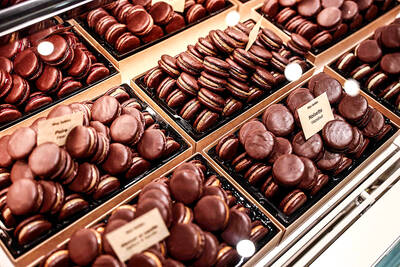The Hwa Kang Museum is up Yangmingshan, Taipei, in a corner of the Chinese Culture University campus. Established in 1971 by the university's founder Zhang Qi-yun (
This four-floor building has approximately 549m2 of
exhibition space.

PHOTO: Courtesy of the Hwa Kang Museum
The first floor gallery is open for exhibitions to both campus artists and members of the public. The third floor is set to display pieces from the museum's
permanent collections of folk arts and Chinese ceramics. The fourth floor exhibition area is designated for large-scale, semester-long thematic presentations of fine arts. The museum's permanent
collection of modern and
contemporary Chinese paintings and calligraphy contains more than 4,000 masterpieces by Chinese artists. Big-name artists include Wang Yang-ming (
In its Chinese ceramics
collection, porcelain and pottery objects are covered through the ages, from the Neolithic Yang-shao culture to the Ming and Qing dynasties.
The folk art and woodblock print collections range from aged furniture, to embroidery, woodblock prints, temple and
monastery art and Aboriginal
cultural artifacts. All these remarkable collections require at least a half-day trip for serious art lovers.
Currently on the fourth floor, curator Margaret Chen (
The late Zhang Shu-qi never set foot in Taiwan in his lifetime and is thus unknown to the general public. Yet, his outstanding skill at drawing pigeons has been lauded by the late Xu Bei-hong (
Born in 1900, Zhang painted the 3m x 3m Hundred Doves in 1941, when China was being attacked by the Japanese. Applying olive trees and azalea flowers as a background, the painting vividly depicts 100 or more doves, each with different expressions. The painting suggests the artist's desire for peace at a time when the clouds of war were gathering.
The painting was subsequently presented to former US president Franklin D. Roosevelt as a gift in commemoration of his third
presidential inauguration. It was displayed in the White House and later became part of the permanent collection of the former president's library.
Zhang was a talented landscape and birds-and-flower painter. One daring approach that Zhang adopted was to use colored Chinese painting papers, instead of normal white ones, for many of his works done in the US.
"He developed a preference for using powdered lead white and red pigment on colored paper. His colors thus became extremely eye-catching," Margaret Chen said. Fang Yi-min
(方亦民), widow of Zhang Shu-qi, donated 40 of her late husband's works to the university in 1969, after Zhang passed away in 1957.
Zhang Shu-qi expresses his desire for peace through painting doves.

Many people noticed the flood of pro-China propaganda across a number of venues in recent weeks that looks like a coordinated assault on US Taiwan policy. It does look like an effort intended to influence the US before the meeting between US President Donald Trump and Chinese dictator Xi Jinping (習近平) over the weekend. Jennifer Kavanagh’s piece in the New York Times in September appears to be the opening strike of the current campaign. She followed up last week in the Lowy Interpreter, blaming the US for causing the PRC to escalate in the Philippines and Taiwan, saying that as

Nov. 3 to Nov. 9 In 1925, 18-year-old Huang Chin-chuan (黃金川) penned the following words: “When will the day of women’s equal rights arrive, so that my talents won’t drift away in the eastern stream?” These were the closing lines to her poem “Female Student” (女學生), which expressed her unwillingness to be confined to traditional female roles and her desire to study and explore the world. Born to a wealthy family on Nov. 5, 1907, Huang was able to study in Japan — a rare privilege for women in her time — and even made a name for herself in the

Would you eat lab-grown chocolate? I requested a sample from California Cultured, a Sacramento-based company. Its chocolate, not yet commercially available, is made with techniques that have previously been used to synthesize other bioactive products like certain plant-derived pharmaceuticals for commercial sale. A few days later, it arrives. The morsel, barely bigger than a coffee bean, is supposed to be the flavor equivalent of a 70 percent to 80 percent dark chocolate. I tear open its sealed packet and a chocolatey aroma escapes — so far, so good. I pop it in my mouth. Slightly waxy and distinctly bitter, it boasts those bright,

This year’s Miss Universe in Thailand has been marred by ugly drama, with allegations of an insult to a beauty queen’s intellect, a walkout by pageant contestants and a tearful tantrum by the host. More than 120 women from across the world have gathered in Thailand, vying to be crowned Miss Universe in a contest considered one of the “big four” of global beauty pageants. But the runup has been dominated by the off-stage antics of the coiffed contestants and their Thai hosts, escalating into a feminist firestorm drawing the attention of Mexico’s president. On Tuesday, Mexican delegate Fatima Bosch staged a